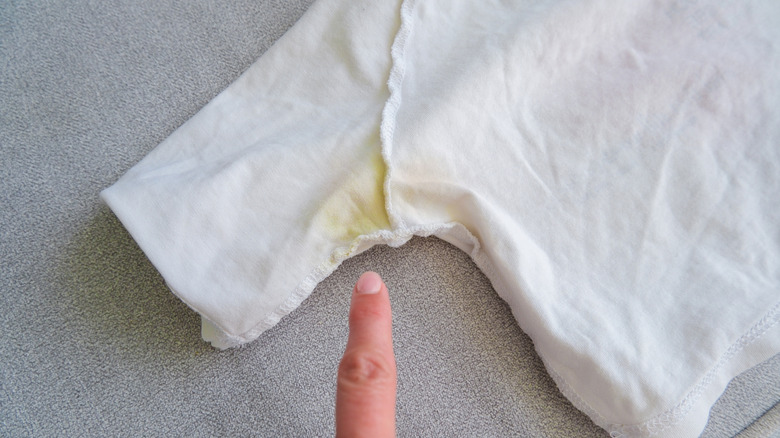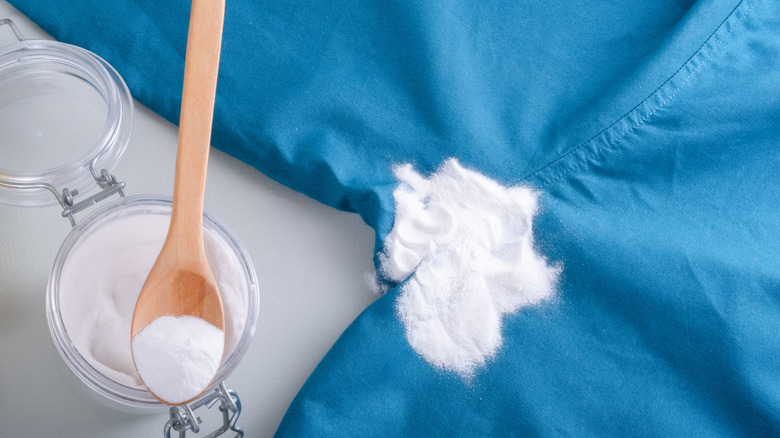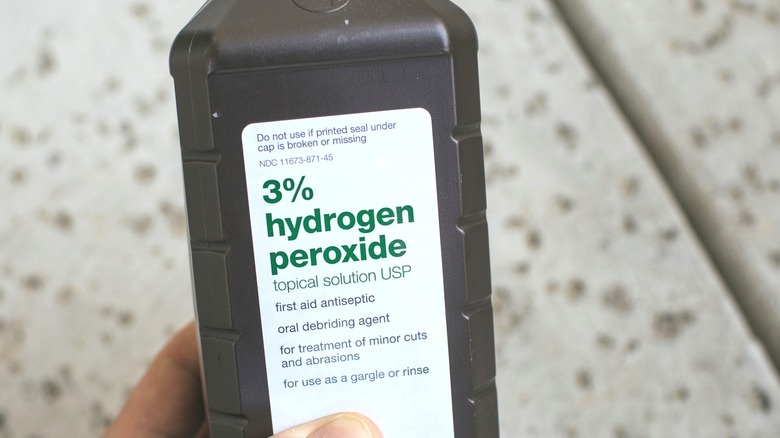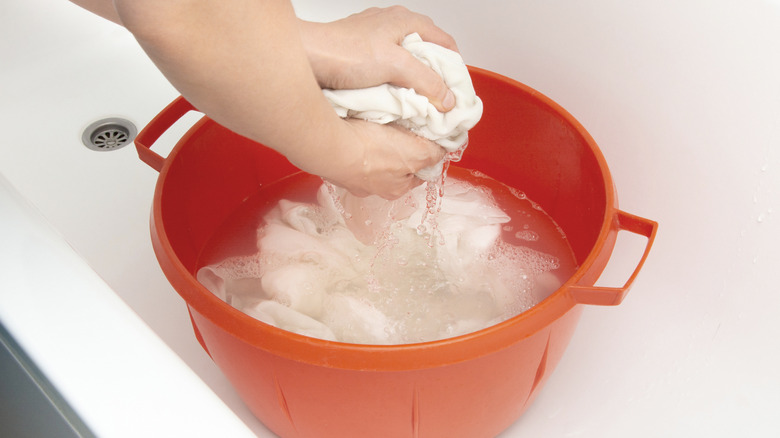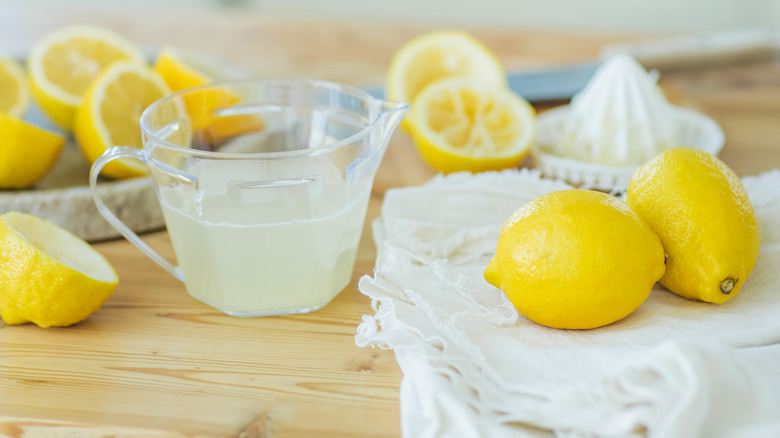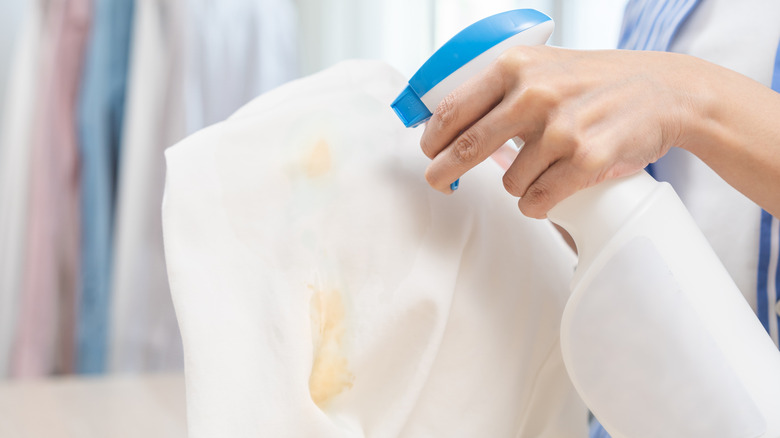The 5 Best Ways To Remove Yellow Stains From Clothing
Have you ever taken a load of laundry out of the washer just to find little yellow stain that simply doesn't seem to go away with regular laundering? Especially common on lighter fabrics, yellow stains can be caused by a number of things: built up body oil and sweat, oxidization, or fabric in contact with substances like nicotine or urine. When it comes to stain removal, many of us reach straight for a bottle of chlorine bleach, which is known for its whitening and stain fighting properties, but actually, bleach can cause yellow staining as well.
It can be very frustrating when your go-to detergent and stain removers don't make a dent, and you might be tempted to get rid of the item altogether — don't be too hasty though, as there are luckily plenty of simple stain removal remedies and products that can eliminate those stains in no time. We've compiled five of the top ways to tackle yellow laundry stains, with options you can find in your cleaning aisle like oxygen bleach, as well as ideas from the produce aisle, like lemon juice.
As a note, even though these methods can be very effective, some of them will need to be repeated to fully eliminate stains depending on the severity and how long it has been on the fabric. When you're done treating and washing each clothing item, check that the stains are actually gone before drying, as a tumble in high heat can further set existing stains.
You can't go wrong with oxygen bleach
We just told you that bleach is ineffective against yellow stains and can even create them, so it's understandable that you might be wondering why we're recommending a substance called oxygen bleach. Although oxygen bleach and chlorine bleach share whitening, brightening, and stain-removal properties, they are very different products. Oxygen bleach's active ingredient is sodium percarbonate, which breaks down to be hydrogen peroxide and sodium carbonate. When it comes into contact with water, oxygen bleach releases — you guessed it — oxygen, which works to lift stains from fabric fibers.
Oxygen bleach can be used to spot treat stains before washing, but it's also safe to use in your washing machine, which makes it ideal for clothes with deep-set stains or white clothes, bedding, and towels that have an overall dinginess or yellowy film. You can find oxygen bleach in almost any grocery or hardware store — OxiClean is probably the best known brand, but any generic or off-brand product will work just as well. Simply toss a scoop full of oxygen bleach in the washing machine tumbler, add your clothes, and wash as usual.
Hydrogen, baking soda, and dish soap are a powerful combo
Remember how we explained that oxygen bleach is little more than hydrogen peroxide and salt? It turns out, hydrogen peroxide is a pretty incredible stain remover on its own as well. If you've only been using hydrogen peroxide as an antiseptic, you're missing out on its secondary application as a laundry stain remover. Hydrogen peroxide is well suited to eliminating biological, protein-based stains such as those caused by sweat, urine, blood, and so on. Hydrogen peroxide can be used safely in washing machines on its own, but you can make it even more effective by combining it with baking soda and a little dish soap to create a spot treatment.
Just combine one part baking soda, one part dish soap, and two parts hydrogen peroxide in a small dish. One of the best parts of this treatment is that it can be used on pesky upholstery and carpet stains that you can't just pop in the washer. Simply work the paste into the stained area and let it sit for a few minutes, giving the hydrogen peroxide time to chemically break down the stains. Then rinse the paste with water to remove it from the fabric. If it's going in the machine, launder as usual, or use a towel to sop up excess moisture from carpet or furniture piece.
Soak clothes in white vinegar
White vinegar is one of the most beloved ingredients when it comes to laundry and stain removal, and it happens to be excellent at getting rid of yellow stains as well. Vinegar is acidic and can break down alkaline deposits, such as those left behind from hard water, or even aluminum in your antiperspirant. As a bonus, white vinegar has lots of uses around the home and is very affordable, so you won't regret adding this wonderful ingredient to your cleaning cupboard if you don't have it already.
You only need to use about one cup of vinegar to a large bucket, pot, or sink basin filled with water to create an effective stain removal solution. Let the stained articles sit for several hours, as long as overnight for especially stubborn stains, then rinse before transferring to the washing machine and launder as usual. A little bonus tip: To eliminate any sour odors in your laundry, just toss a cup of vinegar to the tumbler before washing for added cleaning power.
Go natural with lemon juice, salt, and sunlight
If you grew up in the 90's, you might remember the advice to put lemon juice in your hair to get it blonder. That's because lemons contain citric acid, one of the most common ingredients in easy stain removal solutions thanks to its natural bleaching properties. If you combine lemons with a little salt for abrasive purposes, you'll have an even more effective combo. Keep in mind that the bleaching properties are activated by the sun, so only attempt this on a bright day with little cloud coverage. Just grab a lemon from your fruit bowl and cut it in half, then squeeze the lemon juice directly onto the stain, allowing it to fully saturate the area. Next, sprinkle any salt you have around on top, and gently work it and the lemon juice into the fabric — the salt helps the lemon juice to penetrate deeper into the fibers. Shake off the excess salt, then hang or lay out the stained article in the sun.
We only recommend using this method on white fabrics, as the citric acid can have a bleaching effect on some dyes, causing a splotchy appearance. Similar to vinegar, citric acid can break down alkaline buildup, as well as whiten and brighten the material. This is a perfect method if you just want to use natural items you already have around the house for stain removal.
Enzyme-based detergents can make a difference
Much like hydrogen peroxide, enzyme-based cleaners are very well suited to protein-based stains, so they can be used on any yellowy stains leftover from milk, urine, grass, and so on. These cleaners and detergents, sometimes called bio-formulas, use enzymes to break down stains. Enzymes are created by living bacteria, and when applied to stains, work to break down organic deposits like that olive oil you dripped on your shirt at lunch. In this process, the enzymes take complex compounds and turn them into nothing more than water and carbon dioxide, so washing the stains away becomes an easy task.
Pick up an enzyme-based spray at any home improvement store or cleaning supply aisle. Spritz it over the yellow stain until it's fully saturated, and allow at least 15 minutes for the enzymes to work their magic. Now that the compounds have been broken down, toss the fabric in the wash and launder as usual. You can also use enzyme sprays to get dog urine out of carpet and furniture, but avoid using them on certain materials such as silk and wool. As a cautionary note, some may find that enzyme-based detergents cause skin irritation, though this varies from person to person.
